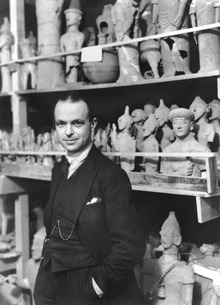Erik Sjöqvist
Erik Sjöqvist (born July 15, 1903 in Ronneby ; died July 16, 1975 in Stockholm ) was a Swedish classical archaeologist .
Erik Sjöqvist was the son of the physician and professor of chemistry and pharmacy John August Sjöqvist (1863-1934) and studied classical archeology at the University of Uppsala with Axel W. Persson . Under the direction of Persson he took part in the excavations in Argive Asine and Dendra in 1926 . In 1927 Einar Gjerstad won him for the Swedish expeditions to Cyprus , where he took part in numerous excavations until 1931 and was responsible for the publication of the excavation results. With the dissertation Problems of the Late Cypriote Bronze Age as the fruit of his personal preoccupation with the finds from Cyprus, he received his doctorate in 1940 at Uppsala University .
But after his time in Cyprus he left the actual area of classical archeology and was librarian at the Royal Library in Stockholm from 1933 to 1939 . At the same time, he also researched archaeological issues during this time and turned to Roman topics with the essay "On the timing of the Helena and Constantine sarcophagi" .
After completing his doctorate, Sjöqvist received his license to teach Classical Archeology and Ancient History at the University of Copenhagen in 1940 . In the same year he was appointed director of the Svenska Institutet i Rom , a position he held until 1948. In the first years there, he devoted himself, among other things, to the ancient topography of the Piazza del Collegio Romano in Rome . With the literary scholar Henrik Schück, he published the two-volume “Rom. En vandring genom seklerna ” (“ Rome. A journey through the centuries ”).
Even before the end of the Second World War , Sjöqvist recognized the need to set up a central point of contact for the foreign scientists who spent the war in Rome, especially since after the end of the war it was expected that numerous foreign scientists would return to Italy in the wake of the Allied troops . Already at the end of 1944, Sjöqvist's preparations for the establishment of the Associazione Internazionale di Archeologia Classica were made, in which Italian, American, English, Swiss and Swedish archaeologists were involved. On December 18, 1944, Sjöqvist was elected the association's first president. On May 5, 1945, the association was officially established with the adoption of the statutes and with the participation of other foreign institutes in the Netherlands, Belgium and Romania. Sjöqvist remained its president until 1948. In 1946 he was one of the founders and until 1948 was also the First Secretary of the Unione internazionale degli istituti di archeologia, storia e storia dell'arte , whose aim was initially to rescue and care for the German libraries in Italy - the Hertziana , the German Archaeological Institute , of the German Historical Institute in Rome and the Art History Institute in Florence - during the post-war years. In 1948 the Accademia Nazionale dei Lincei accepted him as a foreign member.
Subsequently, Sjöqvist was visiting professor at Princeton University in the academic year 1948/49. Another two years away from scientific activities followed, during which he worked as an advisor and private secretary to the Crown Prince and later King Gustav VI. Adolf of Sweden , himself a classical archaeologist, was active. In 1951 he followed the call to the chair of Art and Archeology at Princeton University, an appointment from which the university hoped to revitalize the archeology and antiquity fields. At the suggestion of Sjöqvist, the university began preparing for the excavations in Morgantina, Sicily, in 1953, and from 1955 to 1963 and again in 1966/67, Sjöqvist and Richard Stillwell , Howard Crosby Butler Memorial Professor of Archeology at Princeton, shared the management of the excavation in Morgantina in annual change. In 1963 Sjöqvist was elected to the American Academy of Arts and Sciences . In 1969 Sjöqvist retired. He did not see the publication of the excavation results, most of which were also published in his name.
Publications (selection)
A bibliography of Erik Sjöqvist's writings can be found in: John Rohnström: The Published Writings of Erik Sjöqvist. A Bibliography. In: Opuscula Romana. Volume 9, 1973, pp. 217-220.
- Problems of the Late Cypriote Bronze Age. Swedish Cyprus Expedition, Stockholm 1940.
- Reports on excavations in Cyprus. Revised new edition of the Swedish Cyprus Expedition, Finds and results of the excavations in Cyprus 1927–1931, Volume 1 from 1934. Swedish Cyprus Expedition, Stockholm 1940.
- Sicily and the Greeks. Studies in the Interrelationship between the Indigenous Populations and the Greek Colonists. University of Michigan Press, Ann Arbor 1973.
literature
- Sjöqvist, Erik. In: Enciclopedia Italiana. Appendix 2. Istituto della Enciclopedia Italiana, Rome 1949.
- Erico Sjoeqvist. Antiquitatum cypri siciliaeque exploratori sagacissimo topographo romano experientissimo amici collegae discipuli suecani americanique ID.IUL.MCMLXXIII. P. Åström Foerlag, Lund 1973, ISBN 978-91-7042-013-9 .
- CE Östenberg: Erik Sjöqvist . In: Atti della Pontificia accademia romana di archeologia. Rendiconti 49, 1976/77, pp. 11-20.
- Sjöqvist, Erik. In: Enciclopedia Italiana. Appendix 4. Istituto della Enciclopedia Italiana, Rome 1981.
Web links
| personal data | |
|---|---|
| SURNAME | Sjöqvist, Erik |
| BRIEF DESCRIPTION | Swedish Classical Archaeologist |
| DATE OF BIRTH | July 15, 1903 |
| PLACE OF BIRTH | Ronneby |
| DATE OF DEATH | July 16, 1975 |
| Place of death | Stockholm |
